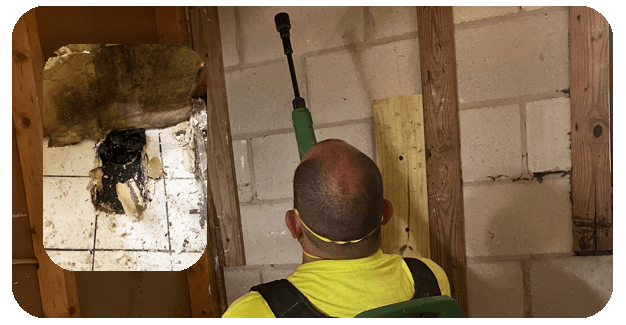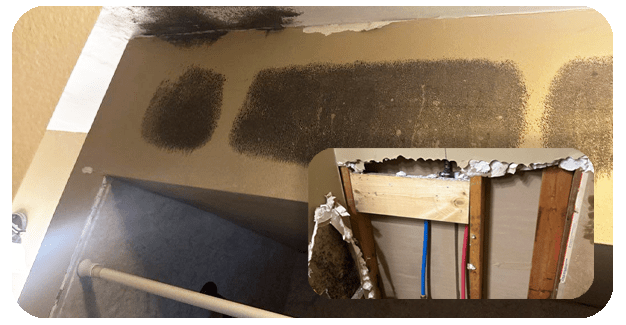
Have you noticed dark patches growing in your bathroom or basement? Those spots aren’t just unsightly – they could be harmful to your health. Removing mold from a house isn’t a simple weekend DIY project. It requires specialized knowledge, proper equipment, and careful techniques to ensure the problem doesn’t return. Let’s explore why calling in the experts is your best move when dealing with fungal growth in your home.
Removing Mold From A House Is A Professional Task ONLY
Many homeowners think they can handle fungal cleanup with some store-bought cleaner and elbow grease. This approach often makes the situation worse. Removing mold from a house requires experts with specialized training to identify different types of fungal growth and determine the underlying cause. They know exactly which techniques work best for each situation.
The pros also use industrial-grade equipment like HEPA vacuums and air scrubbers that simply aren’t available to the average person. Removing mold from a house properly requires containing the affected area to prevent spores from spreading to other parts of your home.
The Hidden Dangers of DIY Mold Cleanup
When you disturb fungal colonies without proper protection, you release millions of spores into the air. These tiny particles can trigger allergic reactions, respiratory issues, and other health problems. Professionals wear protective gear for a reason!
Additionally, DIY attempts often address only the visible problem. The real issue usually extends beyond what you can see. Removing mold from a house involves finding and fixing the moisture source that allowed the growth to begin with. Without addressing this root cause, the problem will keep coming back.
Why Bleach Isn't an Effective Remedy for Mold Removal
Despite popular belief, bleach isn’t the answer to fungal problems. Here’s why:
- Bleach only removes surface discoloration but doesn’t kill the roots on porous materials
- It loses effectiveness quickly and provides no lasting protection
- The harsh chemicals can damage many home surfaces
- Bleach creates harmful fumes that can irritate your lungs and skin
- It doesn’t address the underlying moisture issue causing the growth

Understanding the Professional Mold Remediation Process
Removing mold from a house should start with a thorough assessment. When you hire experts, they follow a systematic approach. First, they conduct a complete inspection to assess the extent of the problem. Next, they contain the affected area using plastic sheeting and negative air pressure to prevent cross-contamination.
The actual cleanup involves HEPA vacuuming, air scrubbing, and treating surfaces with appropriate antimicrobial solutions. Removing mold from a house might require professionals to remove and dispose of materials that can’t be salvaged, like severely affected drywall or carpeting. Finally, they clean the air and surfaces to eliminate remaining spores.
Preventing Future Mold Growth After Professional Treatment
After professional remediation, keeping your home fungus-free requires ongoing attention to moisture control. Fix leaky pipes promptly and use dehumidifiers in damp areas like basements. Proper ventilation in bathrooms and kitchens helps too.
Consider having your HVAC system professionally cleaned, as ductwork can harbor spores. Removing mold from a house successfully means staying vigilant about these preventive measures. Many remediation companies offer follow-up inspections to ensure the problem hasn’t returned.
Why Professional Help is Essential for Removing Mold from a House
The stakes are simply too high to risk DIY solutions when it comes to fungal remediation. Professional services might seem expensive initially, but they’re far cheaper than dealing with structural damage or medical bills from prolonged exposure.
Experts bring the knowledge, equipment, and experience needed to handle the situation safely and effectively. Removing mold from a house with professional help ensures peace of mind knowing that the problem is truly solved, not just temporarily covered up. Your family’s health and your home’s integrity are worth the investment in proper remediation services.
Removing mold from a house is always best left to trained professionals who understand the complexity of the task and have the right tools to get the job done right the first time.
FAQ
Can you safely remove mold yourself?
No, DIY fungal removal is risky business! Small surface patches (less than 10 square feet) might be manageable, but larger infestations require professionals. Without proper equipment and knowledge, you’ll likely spread spores throughout your home. Plus, certain types can cause serious health issues when disturbed. Better safe than sorry!
How do I get rid of mold permanently?
Removing mold from a house permanently requires addressing the moisture source first. Fix leaks, improve ventilation, and use dehumidifiers in damp areas. After professional remediation, maintain indoor humidity below 60%. Regular inspections of problem areas like bathrooms and basements help catch new growth early. Prevention is your best strategy!
Why is removing mold from a house important?
Removing mold from a house protects both your health and property. Fungal spores trigger allergies, asthma attacks, and respiratory issues, especially in children and elderly people. They also damage building materials over time, compromising structural integrity and reducing property value. Quick action prevents these serious consequences from developing.




